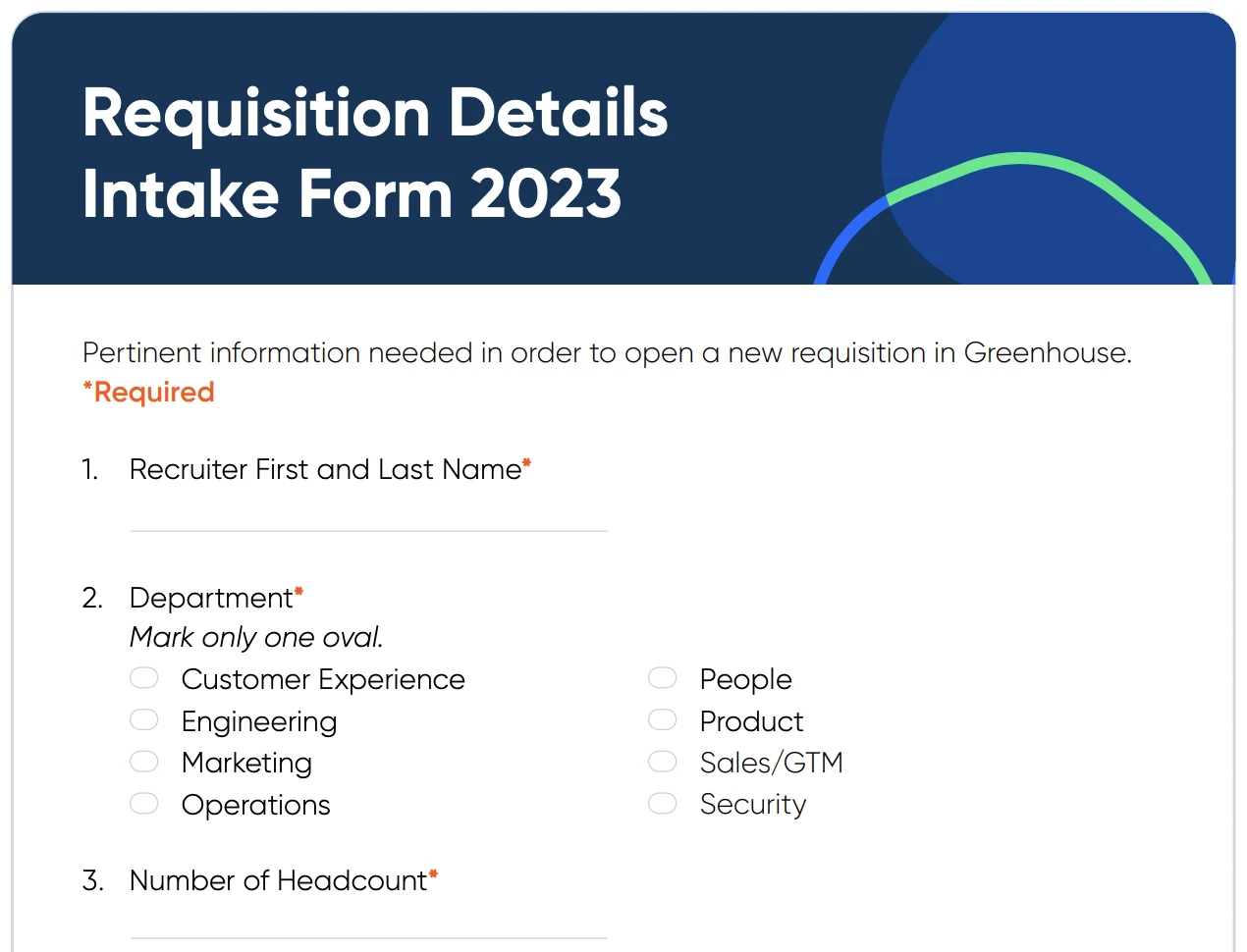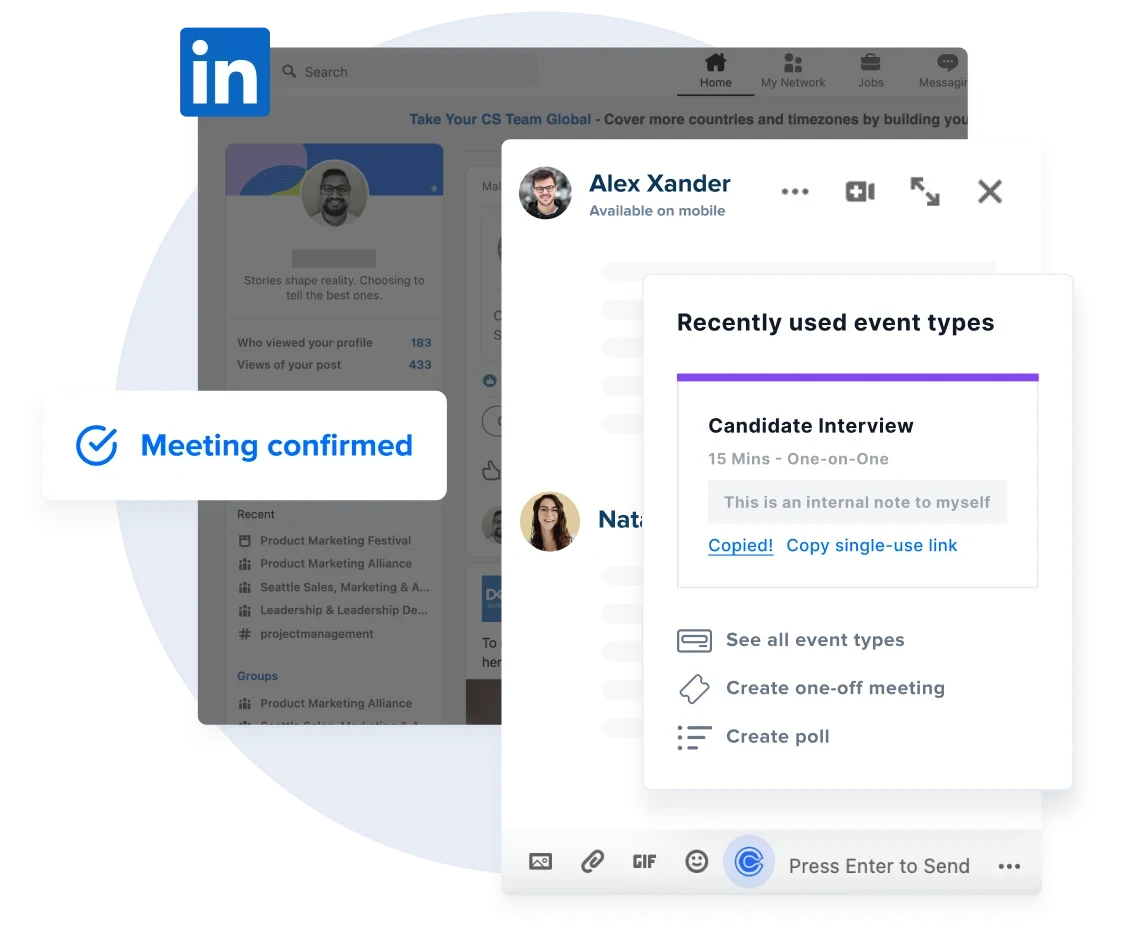Integrations
5 ways to improve the candidate experience and hire top talent
Better candidate experience, better talent. Learn five ways to improve the candidate experience.
Rachel Burns
Apr 18, 2023
11 min read
Table of contents
The hiring process is about more than finding the best candidate for your company’s open position. It’s an opportunity to market your company values and employer brand to top talent.
From the moment they read a job description until they receive an offer, job candidates are judging whether your company is a good place to work.
That’s where the candidate experience comes in. Two-thirds of candidates have rejected offers due to poor recruitment experience. Slow interview scheduling, inconsistent communication, unclear expectations, impersonal interviews … it can all create a poor candidate experience and alienate top talent. And that ladders up to company-wide impact, like customer churn and lost revenue.
Luckily, you have the power to improve the candidate experience! In this article, we’ll walk through five ways recruiting teams can create a positive candidate experience every step of the way — so you can hire top talent and meet your goals.
1. Build partnerships with hiring managers
A great candidate experience begins before a job candidate applies — and even before the listing is posted on your job board. It starts with creating a true partnership with the hiring manager.
“Hiring managers will move mountains for you as much as you will for them.”
Danny Cao
Internship Program Manager at Glassdoor
Hiring managers supply nearly everything you need to get a new job posting live on your careers page, from job description details to initial questions for phone screenings. Recruiting is 100% of your job, but only 10% of theirs, so getting information quickly and accurately can be tricky. That can mean a slower time to hire — and more challenges for your recruiting team later in the process.
You all have the same goal: Hire the best talent for their team and fill the position quickly. So how can you work together to get there?
Start with a kickoff meeting to learn about the new position and discuss the role they hiring manager will play in the process.
“Recruiters should think of themselves as the SME of the interview process. Coach everybody, have regular syncs with the team, set expectations with the hiring manager, and reinforce that you are partnering with them and working towards the same goal.”
David Craft
Manager, CX & Sales Recruiting at Calendly
In your kickoff meeting, ask questions like:
What is the deadline for filling this role?
Is the job description ready to post on the career site?
What does success look like in this role?
Who on your team should be included in the interview process?
Have you blocked out time on your calendar to make interviewing a priority?
Requisition intake forms are another way to gather the information you need to post a new role. “The manager is the critical player, but they don’t love recruiting admin work. Standardized forms make their contribution as easy as possible,” says Kashia Morton, Senior Manager of Recruiting Operations at Calendly.
If your recruiting team doesn’t have an intake form, you can use Calendly's as a template.
Once you have all the details from the hiring manager, make sure your job descriptions clearly list responsibilities, requirements, and benefits. What does a day in the life of this role look like? Job seekers read a lot of postings — so minimize jargon, make it easy to read, and include info that makes the role and your company stand out, like opportunities for growth or industry-leading benefits.
Job descriptions are also an opportunity to incorporate inclusive language into your hiring process. The Calendly recruiting team uses Textio, a workplace language guidance tool, to ensure job descriptions are unbiased and therefore more likely to attract a diverse candidate pool.
Many recruiters support specific teams, so you’ll see the same job reqs come up again and again. For example, a sales recruiter might find themselves posting job descriptions for Sales Development Representative (SDR) and Account Executive (AE) roles every quarter. Instead of starting from scratch each time, work with the hiring manager to create a pre-built job posting with the job description, interview process, and take-home exercises ready to go. You’ll get the job posting live — and fill the role — faster.
Pre-building job postings for specialized and hard-to-fill roles is more complicated, but you can still speed up the process with job description templates. The template should contain the information shared in all your job postings — info about the company, benefits, and application process — so you can simply add the job description and additional details once you've finalized them with the hiring manager.
E-book: The ultimate guide to recruiting coordination
2. Speed up the hiring process with scheduling automation
The top reason candidates withdraw from a hiring process? Recruiters not respecting their time. Nearly two-thirds of candidates say they lose interest in a job if they don't hear back within two weeks, and 78% of recruiting professionals say they’ve lost a candidate because they couldn’t schedule their interviews quickly enough.
When it takes dozens of emails to book an interview, that's a bad candidate experience (and a huge time suck for recruiting coordinators!). On the flip side, when you schedule interviews quickly, you eliminate unnecessary touchpoints, speed up the hiring process, and keep candidates excited about the role.
Interview scheduling should be easy for your team and candidates. Scheduling automation tools like Calendly help recruiters eliminate email ping pong and coordinate interview schedules in just a few clicks — from phone screens to complex, multi-day panel interviews. A study conducted by Forrester Consulting found that recruiting teams achieved a 26% shorter recruiting cycle with Calendly.
For example, allowing candidates to self-schedule makes booking interviews easier and faster. Recruiters reaching out to candidates can use Calendly to add a scheduling link to their email signature or message in LinkedIn Messenger. When the candidate is interested in the role, they can schedule an initial phone screen in just a few clicks.
Scheduling automation also makes it easier to prioritize fast interviews. You can prevent candidates from self-scheduling weeks or months into the future. Instead, aim to schedule screens within one to three days, and face-to-face interviews within three to five days.
Interviews aren’t always one-on-one meetings — so your scheduling automation platform shouldn’t be limited to booking one-on-one meetings. Calendly's collaborative scheduling features makes it easy to schedule group interviews at a time when everyone is available.
Integrations are another way scheduling automation helps recruiters upgrade the candidate experience. If your scheduling tool automatically sends updates to your applicant tracking system (ATS), you never need to worry about a candidate slipping through the cracks.
Within Calendly’s own interview process, we integrate Calendly with Zoom, which we use to host remote interviews, and with our ATS, Greenhouse, to send interview confirmations. Once an interview is scheduled, it automatically shows up on our Google calendars.
Scheduling automation can also keep candidates engaged throughout the process. Calendly’s Workflows make it simple to set up and send a sequence of interview reminders and follow-ups through email and/or text messages. You can include all the information candidates need, like next steps and day-of details.
Last but not least, your scheduling platform should offer reporting and analytics. Whether you want to track interviews, no-shows, cancellations, or team productivity and bandwidth, metrics can help your team uncover opportunities to level up your interview process.
The Total Economic Impact™ of Calendly
A study conducted by Forrester Consulting found that Calendly provided customers a 318% ROI over three years. Read the full study for real customer insights about the benefits of using Calendly.
Example: How Muck Rack sped up their hiring process with Calendly
Before Calendly, Odlenika Joseph, Muck Rack’s Talent Operations Specialist, spent 80% of her time scheduling and rescheduling candidate interviews.
Now, with scheduling automation, candidates can book interviews directly with the right team member’s calendar. Calendly has helped Muck Rack reduce time-to-hire by eight days.
Odlenika uses Calendly’s Managed Events to standardize meeting templates and ensure each stage of the hiring process contains pre-planned meeting Workflows, custom redirects, and follow-up events.
“It’s about efficiency and making more out of less. Leveraging Calendly has enabled everyone on my team to take on a ton of projects that are really impactful to the recruiting team and the organization at large.”
Erica Raphael
VP of People at Muck Rack
3. Communicate clearly, early, and often
Candidates should know what’s coming and how to prepare at every step of the candidate journey — and recruiters are their guides.
During the initial phone screen, take time to discuss the hiring process. How many rounds of interviews will there be? Will there be any technical tests or projects? What is the goal timeline for filling the role?
From there, make sure candidates know who they can contact with questions and what to expect at each step. (We’ll talk more about interview prep in the next section.)
“How can we set candidates up for success rather than setting them up to run into pitfalls or traps that candidates might commonly fall into otherwise?”
Matt Woo
Head of Talent Operations at Ontra
Prompt, honest communication is equally important for candidates you decide aren't the right fit for the role. Job applicants are increasingly being “ghosted” by employers, leaving candidates uncertain about their status.
Don’t be a part of that harmful trend! Follow up with candidates as soon as possible to let them know your decision and share feedback. Do your best to close the loop with every applicant, even if you choose not to extend a job offer.
Recruiting automation and interview email templates can help your team stay in touch with candidates without spending too much time manually sending emails — or losing your personal touch. Your ATS helps you keep track of all candidate communication and even automate it. For example, you could use your ATS to send an automatic email confirming receipt of an applicant's resume, or to follow up with a candidate who hasn't responded to an interview request.
Recruiters and coordinators are often the main point of contact leading up to onboarding, so make sure to tell new hires their start date, how and when they’ll receive any equipment, and what to expect on their first day.
Let them know you’re available to answer any questions about the work environment, company culture, dress code, or anything else — and if you don’t know the answer, connect them with the right person. Helping new hires feel prepared and confident for their new roles goes a long way toward the overall candidate experience.
4. Help everyone prepare for interviews (on both sides)
Interviews can be nerve-wracking for candidates and interviewers alike. And when people on either side feel uncomfortable or unprepared, the interview experience becomes less than ideal for everyone involved.
Set everyone up for success by offering the materials and training needed to knock interviews out of the park.
On the candidate side, consider providing templates, prep guides, and example questions. At Calendly, when candidates schedule their interview with the hiring manager, they receive a robust interview guide with interview tips, suggestions for what to wear, and more information about Calendly’s hiring processes. Candidates know what to expect and feel more confident going into the interview.
“Building a recruiting process that’s inclusive, treats candidates fairly, and doesn't expect people to have certain prerequisite knowledge that not everyone has, is really important in terms of what sort of statement a company is making about how inclusive their practices are.”
Matt Woo
Head of Talent Operations at Ontra
On the interviewer side, develop standard interview questions, rubrics, and skills assessments for each role. This helps keep the process fair for all candidates, and your team gets substantive, informative responses that help make the right hire.
Interview training also helps ensure hiring managers and team members are ready for conversations with candidates. “Everybody who is in contact with one of our candidates has been certified by our internal training,” says Kelly Minella, Head of Recruiting at Calendly.
“It’s a way that we can trust the process we’re giving to our candidates is a positive one, that it’s fair, that it’s consistent. It allows interviewers to feel like, ‘I’ve got this skillset now in my toolbox, I’m confident when I go into this interview and this conversation that it’s going to be a good one and that I know what I’m doing.’”
Plus, the more people who are qualified to conduct interviews, the more scheduling options you’ll have. Different roles require different types of expertise, and you need diverse hiring panels to prevent unconscious biases. It’s also easier to find an interviewer substitute at the last minute.
“Both sides should feel like they can put their best foot forward, have the most productive and open conversation around the opportunity, and make the best decision.”
Kelly Minella
Head of Recruiting at Calendly
5. Ask candidates for feedback
No matter how much you try to perfect the hiring process, there's no guarantee that every applicant will have a positive candidate experience. But those less-than-stellar experiences offer recruiting teams and hiring managers an opportunity to learn and grow.
One way to do this is by sending a candidate experience survey to everyone you interview — whether you extend them an offer or not. There’s no guarantee that a candidate who doesn’t get hired will respond to a survey request, but it doesn’t hurt to ask! Their insights could reveal opportunities for your team to improve.
Plus, your team would rather find out someone had a negative candidate experience in a survey than in a public Glassdoor review or social media post.
You can also ask new hires for feedback during onboarding, when the interview process is still fresh in their minds.
Here are some example questions to include in your candidate experience survey:
Did the job description help you clearly understand what we were looking for?
Did the recruiter clearly explain the hiring process?
Was communication prompt and clear?
Was it easy to schedule an interview time?
Did the interview process help you learn about our company and the position?
Were the interview questions relevant to the position?
What could we have done better?
“You should, end to end, look at the candidate experience and the candidate journey and keep improving and evolving it.”
James Lafferty
VP, Global Talent Acquisition at Epicor
Better candidate experience, better talent
A high-quality candidate experience means attracting and hiring high-quality talent. From posting the initial job listing to soliciting feedback, put the candidate experience at the center of your recruiting strategy.
Scheduling automation can help you take your recruiting process to the next level, whether you’re letting candidates self-schedule or setting up complex panel interviews. Calendly helps thousands of recruiters and coordinators increase candidate pipeline, book more interviews, and fill roles faster — so teams can spend less time on scheduling and more time connecting with outstanding potential employees.
Ready to explore what Calendly's recruiting solutions can do for your team? Learn more or get started right away with a free trial.
Get started with Calendly
Ready to make scheduling easier than ever?
Rachel Burns
Rachel is a Content Marketing Manager at Calendly. When she’s not writing, you can find her rescuing dogs, baking something, or extolling the virtue of the Oxford comma.
Related Articles
Don't leave your prospects, customers, and candidates waiting
Calendly eliminates the scheduling back and forth and helps you hit goals faster. Get started in seconds.
Calendly eliminates the scheduling back and forth and helps you hit goals faster. Get started in seconds.









